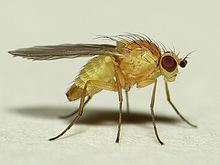Phytomyza ranunculi
| Phytomyza ranunculi | |
|---|---|

| |
| Phytomyza ranunculi Netherlands | |
| Scientific classification | |
| Kingdom: | Animalia |
| Phylum: | Arthropoda |
| Class: | Insecta |
| Order: | Diptera |
| Family: | Agromyzidae |
| Genus: | Phytomyza |
| Species: | P. ranunculi
|
| Binomial name | |
| Phytomyza ranunculi (Schrank, 1803)
| |
Phytomyza ranunculi is a species of fly in the family Agromyzidae. It is found in the Palearctic .[1][2][3]
Life cycle[]

Eggs are laid on plants in the Ranunculaceae family. The larvae are, primarily, leaf-miners. They form a long, conspicuous white mine with the frass present in close strings.[4]
In 2018 the first confirmed adults were reared from stem-mines of meadow buttercup (Ranunculus acris). This is a rare example of 'organoxeny', where a phytophagous insecy occurs on a different part of a plant from where it can normally be found .[5]
The larvae pupates into a greyish or brown puparium, with posterior spiracles each with about 18-20 bulbs.[4] Adult flies are approximately 2 mm in length. Adults are highly variable in colour, with several named variants including a pale form (P. ranunculi var. flava) and dark forms (P. ranunculi var. flavoscutellata and var. islandica).[5]
Distribution[]
The fly is widespread throughout Europe.[4]
Parasitoids[]
P. ranunculi pupae are particularly at risk from parasitism. Up to 75% of all reared puparium have been shown to be parasitised.[5] Parasitoids of this species include numerous species in the hymenoptera superfamilies Chalcidoidea and Ichneumonoidea:[4]
- (Walker, 1839)
- (Nees, 1834)
- (Walker, 1839)
- (Zetterstedt, 1838)
- (Nees, 1934)
- (Nees, 1834)
- Walker, 1838
- (Walker, 1838)
- (Walker, 1838)
- (Walker, 1838)
- (Erdös and Novicky, 1951)
- (Nees, 1834)
- (Zetterstedt, 1838)
- (Walker, 1839)
- (Walker, 1839)
- Miscogaster elegans Walker, 1833
- Walker, 1833
- (Walker, 1934)
- (Walker, 1839)
- (Nixon, 1945)
- Förster, 1862
- (Nees, 1811)
- Ruthe, 1859
- (Nixon, 1954)
- Thomson, 1895
- (Haliday, 1839)
- Thomson, 1895
- (Nixon, 1954)
- Telenga, 1935
- (Haliday, 1839)
- (Haliday, 1839)
- (Nees, 1812)
- Haliday, 1833
- (Fischer, 1957)
- Wesmael, 1835
- (Nees, 1811)
References[]
- ^ Fauna Europaea
- ^ Bei-Bienko, G.Y. & Steyskal, G.C. (1988) Keys to the Insects of the European Part of the USSR, Volume V: Diptera and Siphonaptera, Parts I, II. Amerind Publishing Co., New Delhi.ISBN 81-205-0080-6 ISBN 81-205-0081-4
- ^ Séguy, E. (1934) Diptères: Brachycères. II. Muscidae acalypterae, Scatophagidae. Paris: Éditions Faune de France 28 Bibliotheque Virtuelle Numerique pdf
- ^ a b c d "Phytomyza ranunculi (Schrank, 1803) [Diptera: Agromyzidae]". UK Fly Mines. Retrieved 1 February 2020.
- ^ a b c Warrington, Barry P. (2019). "Organoxeny within Phytomyza ranunculi (Schrank) (Diptera, Agromyzidae) larvae". Dipterists Digest. 26: 5–12.
- Phytomyza
- Insects described in 1803
- Leaf miners
- Muscomorph flies of Europe
- Taxa named by Franz von Paula Schrank
- Opomyzoidea stubs